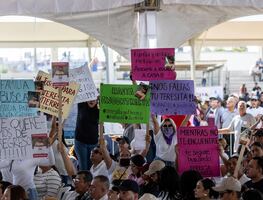Más Información

Osiel Cárdenas, exlíder del Cártel del Golfo, recibe auto de formal prisión; enfrentará juicio por homicidio

Jóvenes mexicanos pasan más de 2 mil horas al año en el teléfono; OCDE alerta sobre su impacto en la salud mental

Sergio Gutiérrez Luna destaca aprobación de 25 reformas en la 66 Legislatura; "Un logro histórico para la 4T", señala

Secretario de Agricultura reafirma defensa del maíz blanco; "Seguiremos apoyando la producción nacional no transgénica", afirma

¿Maíz transgénero? Rubén Rocha corrige desliz durante discurso en Sinaloa; destaca importancia del maíz blanco

Sheinbaum asegura apoyo total a Sinaloa para enfrentar violencia; "Nunca los vamos a dejar solos, aquí está la presidenta"
The number of cells working for the main drug cartels in Mexico has been cut by half during this administration, from 80 to 43, according to reports from the Attorney General's Office (PGR) obtained via the Transparency Law.
The government of President Enrique Peña Nieto "inherited" from his predecessor, Felipe Calderón, eight cartels and 80 cells. Now Mexico has nine cartels and 46% cells less. In turn, Calderón "inherited" from the government of Vicente Fox seven cartels and 27 cells, according to reports of the PGR from the last three presidential administrations obtained by EL UNIVERSAL.
In addition, until the end of April 93 of the 122 most dangerous criminals had been arrested or killed. The hardest hit group was the Zetas, because 30 of its leaders were "neutralized" by the federal government.
An analysis of the official figures revealed that the fall of drug lords and the drop in the number of narco cells contributed to a decrease in violence. According to data from the National Public Security System (SNSP) 5,279 people were murdered in the first quarter of 2012, while in the same period this year there were 27% less homicides: 3,853. Kidnappings and extortion also dropped during the same period, 24% and 22%, respectively.
Less violence
Raúl Benítez Manaut, an expert on security issues, said that cells tend to increase violence, because they lack a central command and follow their own interests, which leads to clashes among them and more extortions, homicides and kidnappings.
The professor of the National Autonomous University of Mexico (UNAM) added that while in Veracruz, Nuevo León and Baja California the government has had many successes, and in Sinaloa violence has decreased, the situation has worsened in Tamaulipas, while Guerrero is in a complete mess.
Gerardo Rodríguez Sánchez Lara, professor at the Universidad de las Américas Puebla, said that the open combat of drug cartels during the previous administration led to an increase in the number of regional cells, which created more violence between rival groups.
Drug cartels operating in Mexico and their cells
The Jalisco New Generation Cartel (CJNG), which in 2013 appeared as a cell of the Sinaloa Cartel, is listed as a separate group in the latest report operating in nine states. A year before it controlled four states.
For Benítez Manaut this means that after the capture of Joaquín Guzmán Loera, leader of the Sinaloa Cartel, many groups left the cartel, benefiting the CJNG.
In the 2013 report the Gulf Cartel was not listed among the main eight criminal organizations. However, the following year it reappeared on the map with 12 cells and presence in Tamaulipas and Quintana Roo.
According to the document Los Zetas went from having three to nine cells. Sangre Zeta operates in Coahuila and Nuevo León, while Tamaulipas is controlled by Grupo Operativo Zetas, Comando Zetas, El Círculo, El Extranjero, Unidad Zetas, Néctar Lima and Grupo Delta Lima.Fuerzas Especiales Zeta controls Quintana Roo and Tabasco, while the cell known as Los Negros operates in Irapuato, Guanajuato.
For Rodríguez Sánchez, this organization has a "survival strategy" based on the expansion of a sort of regional franchises.
At the beginning of this administration the Arellano Félix cartel in Tijuana had almost absolute control of Baja California and Baja California Sur through 14 cells. However, after the arrest of several of its leaders, the cartel lost control of Baja California Sur. Currently it only operates in Baja California, with two cells.
The Juárez Cartel of the Carrillo Fuentes brother practically remains intact. It continues to operate with two cells in Chihuahua: La Línea and Los Aztecas.
The disappearance of a large number of cells in the last two and a half years is partially explained because many of the 23 cells that the Attorney General's Office attributed to Édgar Valdez Villarreal "La Barbie" in 2013 disappeared and only three remained.
La Oficina and the Independent Cartel of Acapulco, that worked for 'La Barbie', joined the ranks of the Beltrán Leyva cartel, while Los Pelones offered their services to the Gulf Cartel.
The Beltrán Leyva cartel, that at the beginning of this administration had 19 cells with presence in 14 states, now has seven cells with influence in six states: Sinaloa, Sonora, Baja California Sur, Guerrero, Morelos and Aguascalientes.
La Familia Michoacana went from having five cells, among them Guerreros Unidos and La Resistencia, that operated in five states, to two, that sell durgs in Morelos, Guerrero and the State of Mexico.
At the same time, the Knights Templar gained more power. At the beginning of this administration they had two cells: Guardia Morelense, that operated in Morelos, and Los Troyanos, in the State of Mexico. Over the months their cells disappeared but the cartel spread to nine states: Michoacán, Guerrero, Baja California, Guanajuato, Morelos, State of Mexico, Jalisco, Colima and Querétaro.




